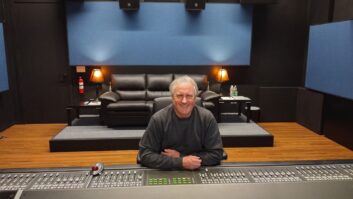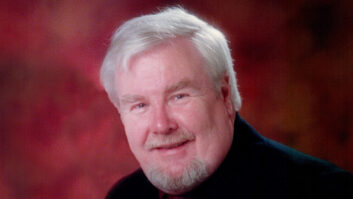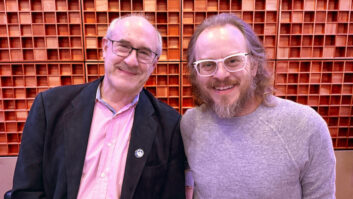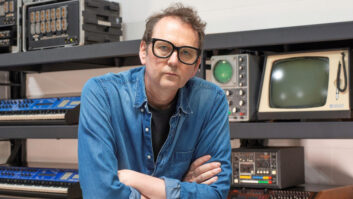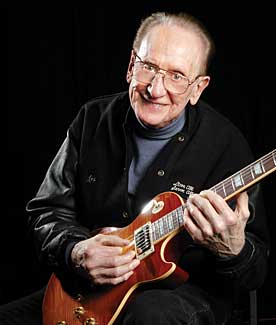
The recording industry and the entire music community owe a debt of gratitude to Les Paul. In addition to being an incredibly creative and gifted musician, Paul was the man who invented the solid-body electric guitar and developed multitrack recording and echo delay. Now he is no longer with us, having passed away on August 13, 2009, at the age of 94.
In 1941, Paul created “The Log,” his first prototype solid-body guitar with detachable “wing” body panels. And after doing overdubbing using record lathes, he began experimenting with the new tape technology that was available after World War II, creating sound-on-sound recordings by adding a switch to disconnect the erase head on tape decks. Installing an extra playback head led him to using tape echo delay. And, finally, he worked with Ampex to create the first 8-track deck capable of sel-sync overdubbing, leading to the multitrack revolution that continues today.
But beyond the inventor, guitar wizard and innovator, Paul was an amazing human being, with an endless love for the people in his field. It’s hard to imagine modern innovators such as Bill Gates or Steve Jobs walking the aisles of a trade show, signing autographs, shaking hands or sharing stories, yet seemingly half of the people in our industry met Paul at NAMM or AES shows, or were warmly welcomed backstage at his many performances in New York City’s Fat Tuesday’s or Iridium Jazz clubs. He was an unceasing performer and a genuinely nice guy. When great legends pass away, the words “There will never again be another” are so often said that the phrase has become cliché, but in the case of Paul, this statement rings true. Farewell, old friend and rest well.
An Industry Pays Tribute
The passing of Les Paul elicited an outpouring of warmth and affection from the recording industry. Here are a few comments Mix received.
Les Paul was not only the musician’s musician, but also the engineer’s engineer and the inventor’s inventor. He discovered that the erase, record and replay heads on a tape machine were not necessarily best placed in that order — thus inventing multitrack recording — and the clincher was that it was on a mono machine.
— Alan Parsons
I first met Les at my uncle’s studio in New York when I was 7 years old, and I’ve been in contact with him through the years. He was like an uncle to me, always patting me on the head. He also had a great sense of humor. I remember at a TEC Awards show, I introduced him to my wife, and he said to her, “You’re not the woman he was with last night.” I will miss him.
— Al Schmitt
I can’t think of anyone who influenced the direction of recorded music more than Les Paul. Overdubbing, double-tracking and tape slapping defined recorded pop music for the next 60 years and continue to do so. His innovations were only matched by his wit and genuine friendliness. I will remember him almost as much for his ability to crack up everyone in a room. How high the moon, indeed.
— Frank Filipetti
Les Paul showed me ways of being musical, yet he was always looking for ways to enhance the sound. He never settled, and when he achieved what he wanted, a glint in his eye told you the maestro had raised the bar again. I will miss you, Les.
— Phil Ramone
When Bruce Springsteen was awarded the Les Paul Award, he was on tour and asked me to accept it for him — an honor for which I am truly grateful. I was at the same table with Les and his son. Les was 88, and by the end of the TEC Awards show, his son Rusty and I were dragging, while Les was perky and looking for the next conversation! What a guy.
— Bob Ludwig
Two famous Pauls get together: Les Paul and Paul McCartney.
I had the honor of going to Les Paul’s house to interview him for a documentary. It was like entering hallowed ground, as the great man graciously showed us his collection of wonderful “goodies” including The Log, his “dancing shoes” and a Cadillac flywheel-driven disk cutting lathe. Then he demonstrated his pride and joy — the 1-inch 8-track Ampex machine — and he proceeded to crank up all the volume on the outputs. I listened in awe, as he said, “See, no hiss!” — Eddie Kramer
My first real guitar was a Les Paul. Still have it. My dad gave up buying a new car so I could have it. I cried when I got it, and it changed my life. I never imagined that I would actually play with him, but it’s a memory that I will take with me forever. I am honored to have been in the presence of a true genius. — Steve Lukather
When I was a child, my Boy Scout troop was given a short tour of Mr. Paul’s studio. I had never seen such as thing. That 8-foot-tall 8-track was something. Years later, a similar machine was in use at Atlantic Studios on Broadway [New York City]. The old Columbia Studios on East 52nd Street had similar machines, too. The last time I saw Les was at the TEC Awards, where Robbie Robertson was given a new Les Paul. Les looked over the guitar and told [Gibson CEO] Henry Juszkiewicz about some ways to improve it!
— Elliot Mazer
I remember the day I met Les Paul like it was yesterday. Actually, it was in 1959. I was at Universal Studios at 46 East Walton in Chicago, working with Quincy Jones on Dinah Washington’s What a Diff’rence a Day Makes album. Les Paul’s new Ampex 8-track recording machine was just being delivered. The machine was absolutely enormous, based on the big, rugged Ampex Model 300 tape deck with eight Ampex Model 351 electronics units.
— Bruce Swedien
I first met Les Paul in 1959. As a guitarist, composer, electronic innovator and inventor, he was beyond genius and there was none other like him. He was a true musical gift from God to the world and spent his life honoring that gift.
— Randy Bachman
My favorite memory is when one of Les’ friends brought a woman and her son backstage to meet him. Les was told that the boy was a Les Paul fan and that his father had recently died. After a few minutes of conversation with the family, Les asked the boy if he owned a Les Paul guitar, and, if so, did he have it with him. He admitted that he owned a Les Paul guitar and that it was nearby. Les offered to autograph it. Afterward, Les advised him to sell his autographed guitar, buy two more and then bring them to the club so Les could autograph them, too!
— Wes Dooley
Unfortunately, I never had the honor of meeting Les Paul, but if it weren’t for him, I’m quite sure no one would have ever heard of me. He basically invented everything I know.
— Bob Clearmountain
A virtuoso musician, inventor and well-loved personality with charm, style and a gift for making people laugh — Les Paul had it all. From electric guitars to sel-sync and multitrack recorders, to effects, including Capitol Studios’ echo chambers, to still gigging in his 90s, Les had an incredible career and will remain an inspiration to us all.
— Maureen Droney
I well remember the early days of the “track race.” Two-track machines were for stereo — in case that ever caught on! In 1958, Decca decided to record all of its classical music in stereo — expensive and virtually impossible to edit, but one day it would pay off. In the mid-1960s, I was building multitrack mixers with 3-track monitoring for Philips Records. Three tracks? There was something about a “hole in the middle” if you only had two tracks. Ampex then came up with four tracks, which they labeled L, C, R and S. The “S” being for “Spare.” Meanwhile, others called it “V” for “Voice.”
Once, Philips’ London studios asked if I could do a console with an output matrix that would enable musicians to mix and remix to end up with a multiple voice chorus. From there the race was on, as more uses were found for multitrack recorders and consoles. At the heart of it were Mary and Les, driving new ideas with seemingly endless enthusiasm. We’ll never forget them and what they did for our industry. There are few today who share the integrity of this Godly man who earned the love and respect of us all.
— Rupert Neve
It was truly a joy to meet Les Paul, as well as receive the Les Paul Award. Multitrack recording is something I listened to since I was a little boy. I remember hearing “How High the Moon.” I was always curious and excited about it. When I was beginning to do recording at Motown in my teen years, being able to play different instruments and sing different parts was very exciting and with Music of My Mind, Talking Book, Songs in the Key of Life and other albums, multitrack recording gave me a chance to really express my concept of an arrangement. I want to meet all of the great musicians that are accumulating in the band in heaven, and Les Paul’s another person included in that great band.
— Stevie Wonder
I remember getting a call from Les a few days before a VH1 special he was asked to play at. “You’re the only guy I know in that rock crowd that knows all the standards, so I need you to play bass. Can you do it?” I said, “Of course.” I would do just about anything for Les. He was and still is a great role model — the perfect combination of a great player and a tech head. And he did it all with a twinkle in his eye. It doesn’t get any better than that.
— Jeff “Skunk” Baxter
My most vivid memory of Les concerns what a wickedly funny guy he was. I saw him in the late ’80s performing in a trio at the Great American Music Hall in San Francisco. Les was clearly using pickup musicians for this gig, and Les frequently introduced fresh musicians to his band with some onstage hazing.
After a few tunes, Les asks the bass player if he knows “how to play Texas-style.” The young bassist looked embarrassed and said “No.” Les feigned outrage, and then said, “You have to know how to play Texas-style,” and in mock disgust, added, “Let me show you how.” He tells the guy to play a walking bass pattern and then tells him to “lower the neck.” As the drummer starts grooving, the bassist lowers his standup acoustic bass neck about 5 degrees, and Les says, “No, further.” This repeats six or seven times, with the neck going lower and lower until he’s whacking his strings with the side of the bass resting horizontally on the stage and standing over the bass’ body instead of behind it. The audience is shrieking with laughter by now as the bassist tries to follow the iconic bandleader’s instructions. At that point, Les congratulates the guy for being such a good learner with, “Hey kid, you did it! You learned how to play Texas-style!” and then asks the audience to give the guy a round of applause!
— D.K. Sweet
Like everyone else, I was deeply saddened by Les Paul’s passing. I always thought of Les in the same light as Thomas Edison. Pure genius. He was the kindest, most generous and thoughtful man I knew. He left a huge impression on everyone he came in contact with and will be missed more than any words can say.
— Elliot Scheiner
For more on Paul, visitmixonline.com/ms/les_paul.
LES, IN HIS OWN WORDS
Teenage Multitracking
“My first attempt at multitrack recording was back in the late 1920s. My mother had a player piano, and much to her surprise I would take her piano rolls and punch extra holes in the paper to create new intros and harmonies.”
The Les Paul/Richard Nixon Connection
As a longtime friend of Les Paul, I have many good memories about him and I’d like to share one here. I once called Les in April 1994, and as we made some small talk I asked him if he heard about Richard Nixon, who had passed away the weekend before. As soon as I mentioned the name “Richard Nixon,” Les suddenly became belligerent, screaming “Richard Nixon — that good for nothing &%#$&#$!!!” Once I got Les to calm down somewhat, I meekly asked, “So I guess you didn’t like that guy?”
In some very strong words, but in a far-calmer voice, Les finally replied that he hated Richard Nixon. I asked why, and he said it went way back to the days when that &%#$&#$ Nixon was VP.
Les explained that back in 1953, he got a phone call from Nixon. Once he heard the voice say, “This is Richard Nixon,” Les muttered (expletive deleted) and hung up. A minute later the phone rang again, Les picked it up and the routine repeated. Finally, the phone rang a third time, with Nixon saying, “Les, this is really Richard Nixon,” thinking the reason for the earlier hang-up was because Les assumed it was a prank call.
Figuring he wasn’t going to shake the VP, Les stays on the line, and Nixon asks whether Les and Mary Ford could play a command performance at the White House for President Eisenhower. Les didn’t think much of Nixon, but he was definitely in the “I Like Ike” camp and agreed to do the gig.
The day of the show came and everything went fine — until halfway through the set, when Nixon jumps onstage and asks Les to play a request for the First Lady. At this point, Les is worried because he and Mary are playing to backup tracks, with Les using a footswitch to trigger the start/stop cues on a tape recorder/amplifier hidden in a box he sits on during the show. The tape has rhythm guitar and Mary’s harmony parts sequenced on the tape. There’s no way to change the order of the songs during the show, and he doesn’t want to reveal that their amazing full stage sound comes from taped tracks — a common practice now, but certainly a rarity in 1953. Finally, Mamie Eisenhower says she wants to hear “Vaya Con Dios.” Les clicks on the footswitch and begins playing. Coincidentally, “Vaya Con Dios” was the next song on the tape!
— George Petersen



